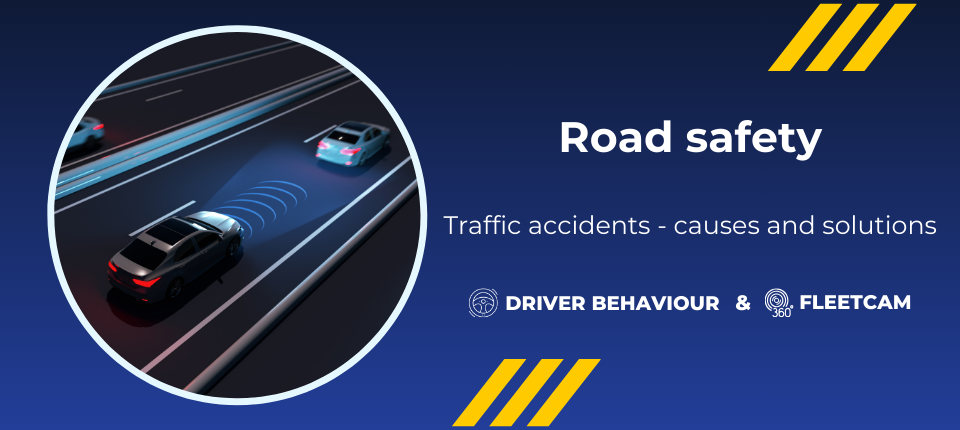Traffic accidents remain a critical issue in Romania. The consequences are devastating and impact both human lives and the economy.
Recent traffic accident statistics
In 2023, 4,526 serious traffic accidents were recorded across Romania, resulting in 1,545 fatalities and 3,536 serious injuries. While these numbers are concerning, they show a slight improvement compared to the previous year (source: https://www.politiaromana.ro/ro/structura-politiei-romane/unitati-centrale/directia-rutiera/statistici).
Compared to other European Union countries, Romania ranked second for fatal road accidents in 2023, with 81 deaths per million inhabitants. Although there was an improvement compared to 2022, when the rate was 86 deaths and Romania ranked first, the country remains far from the EU average of 46 deaths per million inhabitants. This disparity underscores the need for initiatives to enhance road safety in Romania.
Where should our efforts as road users be focused? To answer this question, we start by analyzing the main causes of traffic accidents in 2023:
- Excessive or inappropriate speed: Caused 733 traffic accidents, 312 fatalities, and 607 serious injuries.
- Failure to yield to other vehicles: Caused 429 traffic accidents, 88 fatalities, and 350 serious injuries.
- Failure to yield to pedestrians: Caused 364 traffic accidents, 81 fatalities, and 324 serious injuries.
Driving under the influence of alcohol remains the most frequent cause. This highlights the need for stricter measures and more effective monitoring by authorities to prevent such dangerous behaviors.
These accident statistics also point to the lack of educational programs, particularly for novice drivers, to develop preventive driving behavior. Additionally, Romania’s poor road infrastructure and inconsistent enforcement of penalties are other significant factors contributing to these statistics.
Efforts to improve road safety
To reduce the number of traffic accidents, the responsible police structures intensified control actions in 2023. They conducted 58,385 operations—4,624 more than in 2022, representing an 8.6% increase. These efforts have been crucial in maintaining some stability in accident numbers. However, progress is insufficient to meet the European-level targets.
Control actions alone are not enough to achieve significant improvements. Romania urgently needs large-scale strategies, programs, and initiatives directly targeting road safety improvements. These should equally focus on both infrastructure and driver education.
Recognizing the need for preventive driving
If infrastructure improvements remain challenging, it becomes increasingly clear that efforts must focus on aspects we can directly influence. Namely, our driving style. A significant portion of traffic accidents is caused primarily by drivers’ lack of knowledge about recognizing and avoiding dangerous situations.
Analyzing driving behavior can accurately indicate the most frequent mistakes made by a driver and the high-risk situations they encounter most often.
AROBS TrackGPS solutions: Driver behaviour and FleetCam
Modern technology plays a crucial role in improving road safety. Solutions offered by AROBS TrackGPS, such as Driver Behavior and FleetCam, are essential for companies looking to reduce accident risks in their vehicle fleets. These solutions identify risk factors that can inform the development of internal strategies tailored to specific issues. Educating drivers on preventive driving practices can create a significant impact on their safety, the company’s activities, and even other road users.
Driver behaviour is a solution that allows detailed real-time monitoring of drivers’ behavior. It also provides accurate data on compliance with speed limits, sudden acceleration and braking, idling periods, and other critical driving aspects. It helps identify high-risk drivers, offering fleet managers the opportunity to implement corrective measures. These may be additional training or counseling, to promote a preventive and eco-friendly driving style.
The FleetCam solution enhances safety by mapping telematics data with video information. This is achieved by integrating cameras inside and outside vehicles, covering a complete 360-degree view. The solution provides clear video evidence in the event of an accident, such as sudden braking, sharp turns, or accelerations, helping determine causes and accountability. This video evidence becomes especially useful under Emergency Ordinance OUG 84/2024, which now allows audio-video recordings to be used in the enforcement of penalties for aggressive driving behavior.
Below we mention some of the maneuvers defined as aggressive behavior, according to Article 54 of the Road Code:
- Successively moving from one traffic lane to another or from one row to another, alternating from left to right, in order to overtake a line of vehicles traveling in the same direction;
- Driving the vehicle at a very short distance from another vehicle, either in front, behind, or alongside it, or suddenly reducing the speed of travel without a justified reason, in a manner likely to intimidate the driver of the other vehicle;
- Repeatedly using sound and/or light signals in a manner intended to unjustifiably force the driver of the vehicle in front to free the traffic lane;
- Reversing a vehicle with the intention of intimidating other road users traveling behind;
- Intentionally driving a vehicle by repeatedly accelerating the engine in a manner likely to disturb people in the vicinity of the public road.
Evidence is recognized even if recorded by other road users through any type of recording device, without the need for approval. However, the recordings must include the following elements to be considered, as specified in Article 109 of the Road Code:
- An extract of the frame from the audio-video or video recording capturing the aggressive maneuvers perceived by the road user;
- The date and time when the aggressive maneuvers were captured;
- The location or elements that can lead to identifying the place where the aggressive maneuvers were captured;
- The vehicle involved and its registration or license plate number, as applicable;
- The road signage of the public road sector where the aggressive maneuvers were captured, relevant to determining the offense.
The FleetCam solution integrates telematics data with video, ensuring all conditions are met for a thorough evaluation of any incident. Video data is transmitted to the FleetCam platform, where fleet managers can monitor all vehicles in various ways: live tracking, event-triggered notifications, or accessing the media gallery to organize, view, or download recordings.
Future Perspectives
Traffic accidents remain a major challenge, but the good news is that modern solutions are making significant strides in improving road safety. Technology has the potential to fundamentally change the way we manage road safety, offering tools that not only prevent accidents but also protect lives and reduce associated costs.
Only through sustained and concerted efforts can we hope for a safer future on Romania’s roads, where traffic accidents become increasingly rare.




